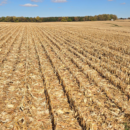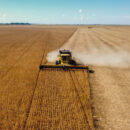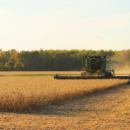FNC News
2024 July Land Values Press Release
According to Farmers National Company, the agricultural land market has been “nothing short of exceptional during the past five years.” Gains in value are prevalent across all classes of land in every region of the country. Strong commodity markets, moderate interest rates, buyer demand, and an overall healthy agricultural economy have also supported the growth of land values during this time.
“But a lot has changed in the past 12 months, and even more has changed within the past five years,” said Paul Schadegg, senior vice president of real estate operations at Farmers National Company. “Moving into the second half of 2023 and the first half of 2024, we’ve experienced significant increases in interest rates, declining grain markets, and inflation. Despite these negative pressures, the land market has remained relatively resilient but shows signs of settling in general, including single-digit decreases in specific areas.”
One aspect of the agricultural land market is the long-term appreciation of land value. Over the past 25 years, land values have experienced a stair-stepping trend following the ups and downs of the agricultural economy. As grain markets and farm profitability rose, the land markets followed while leveling off as markets and profitability did the same. Schadegg said each plateau has set a new value standard sustained through production, demand, and profitability.
“A significant factor in maintaining the level of land values has been investor interest in the market. While these bidders are not always successful buyers of land, they are certainly involved in setting the floor on values as they bid up to the levels of their investment criteria. This segment of buyers also considers the long-term appreciation in value we have experienced in the past 25 years, the potential for future appreciation, and land’s value as a diversified asset,” Schadegg said.
As buyers consider land purchases during the second half of 2024, the additional expenses for interest and lower commodity markets will be at the forefront of their decisions. Schadegg said that the market value of land will adjust according to the level of demand and profitability potential.
“We anticipate variations in land value changes across our regions in the U.S. Areas with strong supply/demand scenarios, an expansion of alternative land use projects and irrigation water concerns may experience more dramatic increases or decreases in values,” Schadegg said. “There remains a strong appetite for land as an investment from outside investors and ag producers. The investor is looking for an asset that will produce an annual return, while the ag producer may look for expansion opportunities. Emotion comes into play when the ag producer is motivated by adjoining land, operation expansion, or land that has potentially never been offered for sale in the area.”
With farm operators being the largest segment of land buyers, the biggest impact on land values moving forward will be profitability in agriculture. If profit opportunities are limited, motivation to buy will decrease and, subsequently, pressure land values into a downward trend.
“Farmers National Company and our agents continue to see strong demand for real estate services across our marketing regions. Listing volume and closed transactions at the company match the pace we saw in 2023, with activity and interest building into the fall selling season. The listing volume and transaction results remain well ahead of the company’s 5-year average,” Schadegg said.
Many upcoming sales have transitioned back to standard listings as sellers reserve the option to negotiate values in a changing land market.
“This is an exciting time for agriculture land owners across the US. Your land asset has never been more valuable than it is today. The strong demand for ag land and its historical appreciation in value will continue to support the current values as we progress into the second half of 2024,” Schadegg said.
REGIONAL LAND VALUE REPORTS
East Region: Indiana, Ohio, Michigan, Kentucky
Despite major reductions in grain prices during the past 18 months, highly productive and tillable farms in this region have held values near recent record highs, according to Jay Van Gorden, area sales manager for the east region.
“Less productive and lower tillable acreage farms have seen a 5 to 10% decrease in value but still much less reduction than grain prices, which are 25% to 30% lower over the past 1.5 years,” Van Gorden said. “Farmer operators remain the primary buyers of farmland, but prices in the eastern region are also driven by investor interest and 1031 tax deferred exchange buyers around several of the larger cities in our eastern territory, which can drive prices higher, especially for several counties out in the countryside as sellers of development property look for replacement land.”
East-Central Region: Illinois and Wisconsin
Land sale values have remained on a slight yet steady incline in most areas in this region, according to Nick Westgerdes, area vice president of the east-central region.
“Many farms are still being sold at historically strong levels; however, record-breaking sales are now few and far between. We've seen several auction ‘no-sales’ the past few months, which is a sign that seller and buyer expectations are not aligning as previously,” Westgerdes said. “The number of land sales in Illinois was down some 35% in 2023 compared to 2022, and we see this trend of fewer sales continuing into the summer of 2024. The current sentiment of most brokers in our area is that the remainder of 2024 will bring about a tendency for land values to level off and stabilize. We do not anticipate either a large drop-off or a dramatic increase in land values over the remainder of the year.”
Central Region: Iowa
Farmers National Company has seen more pressure on values in the last six months, with the lower quality and marginal land receiving the most scrutiny, according to Thomas Schutter, area sales manager for the central region.
“This is due to the prolonged higher interest rates and lower commodity prices. High-quality land remains the most stable, with strong sales still reported in some areas. One saving grace for values is that we’ve seen a lower land supply on the market this spring. This may have helped stabilize values for a time, but we anticipate that volume will increase through the remainder of the summer months and into the fall,” Schutter said.
While buyer interest has varied lately, Schutter added that overall buying power is down from its peak two years ago.
“That doesn’t mean buyers are no longer interested but are more selective in their purchases. Heavy spring and summer rainfalls have also taken an emotional toll on some local buyers, especially in northwest Iowa and southwest Minnesota, where flooding is most prevalent. With land values under pressure, it’s important to understand your local market,” Schutter said.
Southern Region: Texas, Oklahoma and Arkansas
The southern region includes multiple geographic areas with different land use types and varying values. In the Mid-South, Arkansas, and Missouri Bootheel, the values remain stable. However, as you move from southeast Arkansas into Missouri, the values increase compared to other portions of the Mid-South, according to Tyler Ambrose, area sales manager for the southern region.
“The highest priced farmland is precision leveled with excellent soils and abundant groundwater. Prices for this type of land ranges from +/- $6,500 per acre in southeast Arkansas to +/- $11,000 per acre in the Missouri Bootheel,” said Bill Shannon, senior farm manager for the southern region. “As you move to the Texas/Oklahoma Panhandles and South Plains, there is an indication that demand is a little softer than a year ago. Also, in this portion of the region, we are seeing a slight decline in value for all land classes, including pasture, dryland cultivation, and irrigated cultivation.”
Shannon noticed that ranch land prices have stabilized in north-central Texas and around the DFW Metroplex.
“In several counties in this area, wooded pasture tracts are still being developed into rural residential subdivisions as the Metro area continues to expand. Most of these sales for residential development are tracts of less than 100 acres. Improved and native pastureland with greater than 200 acres with influence from the Metro area have values that range from $6,000 to $12,000 per acre,” Shannon said. “Larger ranch properties in the Cross Timbers Region west of Fort Worth of greater than 2,000 acres have a value range from $1,200 to $3,000 per acre. Recreational properties in the central Texas area are still seeing a slight increase in value and demand.”
South Central Region: Kansas, Eastern Colorado, and Western Missouri
According to Steve Morgan, area sales manager for the south-central region, headwinds and tailwinds have combined to keep the high-quality land market in western Missouri, Kansas, eastern Colorado, south-central Nebraska, and north-central Oklahoma values steady over the past 12 months.
“While a few small areas within those states continue to see new highs, other areas have shown signs of a small retrace. This region has also begun to show a little price weakness in the average to below average quality land market,” Morgan said. “Drought, heat, lower inventories of land for sale, and volatile commodities are still all at play across the region. So far this spring and early summer, the drought map has improved, and commodities have shown signs of occasional strength. These make us very friendly to a strong fall and winter land market, especially if the industry continues to see a low inventory of farms for sale.”
Western Region: Western Nebraska, Northwest Kansas, and Northeastern Colorado
According to Cole Nickerson, area sales manager for the western region, farmland prices in central and west Nebraska and northeast Colorado have struggled to maintain the record highs of recent years.
“High-quality irrigated farmland remains in high demand with a low supply, which has helped keep prices elevated,” Nickerson said. “Lower-quality farmland has experienced some discounting over the past six months. Rangeland prices have remained stable due to strong cattle markets. One would expect a sharp increase in rangeland prices with the strong cattle markets, but that has not been the case. Low cattle inventories across the country have tempered demand.”
Recent sale highlights:
- 159.36 acres of Custer County, Neb., irrigated land for $10,100 per acre
- 160 acres of Valley County, Neb., irrigated land for $8,500 per acre
- 77.48 acres of Antelope County, Neb., dryland and pasture for $7,425 per acre
West-Central Region: Eastern Nebraska and Western Iowa
Chanda Scheuring, area sales manager for the west-central region, said land values in eastern Nebraska and western Iowa have stayed mostly steady.
“It will be interesting as we enter this fall selling season if those prices will continue to be supported given the lower commodity prices and higher interest rates. Some softening, especially on less productive land, may be seen over the next six months,” Scheuring said. “One certain thing is there appears to be a tightening of supply in the market. As an industry, fewer properties come up for sale over the past year. This, no doubt, has helped support prices since demand for quality farm ground has remained high.”
Northern Region: Dakotas and Western Minnesota
When evaluating Farmers National Company's land sales this spring and looking ahead to the fall of 2024, one constant will remain the same—quality is king, said Troy Swee, area sales manager for the northern region.
“On average, we have seen a softening in land sales since the uptick in interest rates and the downturn in commodity prices, but demand for high-quality land remains extremely strong and is still bringing at or near record high prices,” Swee said. “A few examples of this would be the 160 acres in Polk County, Minnesota, that brought $1,408,000, and the 800 acres in Aurora County, South Dakota, that brought $6,336,000. A lack of inventory for sale also supports land values across the region, and our auctions have been very well attended with plenty of farmers and investors looking to add to their land portfolio,” Swee said.
More News




